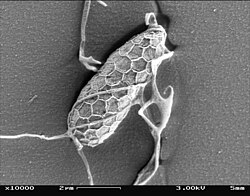| Sagenista | |
|---|---|
 | |
| Aplanochytrium, a labyrinthulid | |
| Scientific classification | |
| Domain: | Eukaryota |
| Clade: | Sar |
| Clade: | Stramenopiles |
| Phylum: | Bigyra |
| Subphylum: | Sagenista Cavalier- Smith, 1995 [1] stat. n. 2006 |
| Groups | |
Sagenista is a subphylum of heterokonts containing the labyrinthulids and Eogyrea, a class of yet uncultured protists. Originally, it contained the Labyrinthulids and bicosoecids. The bicosoecids have been removed, and Eogyrea were added, in order to make the group monophyletic. [2] [3] [4] [5]
Contents
Some have a special organelle called a bothrosome (or sagenogenetosome). It is usually found in a marine environments rich in algae and sea grass. It is capable of movement by use of this organelle.[ citation needed ]
They are generally decomposers. They are cultivated for their active production of Omega-3 fatty acids. These acids are used as an approved additive for animal feed.[ citation needed ]
There is a debate about whether some species of Sagenista contain the photosynthetic pigment chlorophyll C.[ citation needed ]